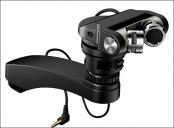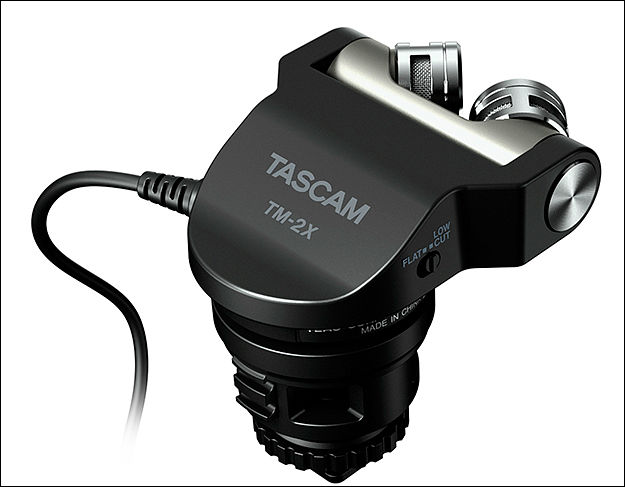
It allows to keep PV going, with more focus towards AI, but keeping be one of the few truly independent places.
-

 tasc.jpg625 x 487 - 37K
tasc.jpg625 x 487 - 37K
 tasc1.jpg618 x 455 - 38K
tasc1.jpg618 x 455 - 38K -
Hi, everyone , I just got it from officail retailer(Taiwan)
I find it is so sensitive, advoid to close to some elctrotronics, like AC Adopter or fluorescent lamps, or it makes some noise.
, This is my test.
Setting:High/Low Cut, with windjammer(include in the box).
Pro: So Sensitive Without Battery Lower price nice build free windjammer
Cons: Some EMI Noise, or some antenna effects( I do not know where the noise it comes) Without -20db switcher(like Rode Video mic) Without arm, poor anitshock (but it still works)
-
It appeared on EU site at http://www.tascam.eu/en/tm-2x.html
-
I use the Tascam TM-2X with my Sony a7S. It's decent. It checked off a bunch of important boxes for me. It's small and light, so I can use it with a steadycam. It uses plug-in power, so I don't have to worry about batteries. The integrated shock mount is good enough. Directionality is good. Sensitivity is good. Handling of high sound pressure levels is good. Self noise is o.k. Flatness of the frequency response is o.k. It's certainly not as good as the AT3031 mics I use when I'm using a separate recorder, but for an on-camera mic it's good enough.
Its resistance to wind noise is way above average for cardioid mics, and let me tell you, that's a really big deal. The included fur windshield is also quite good, such that wind noise is seldom a problem with the windshield attached. Any wind noise I get is mostly a low frequency rumble that I can filter out. Install the windshield a bit away from the mount so it doesn't rub on the mount when the shock mount moves around.
The mic is quite susceptible to radio frequency interference. I was getting quite a lot of interference from the camera. I fixed it by routing the microphone cable up and away from the camera (wrapping the extra length twice around the mic's mount in the cable grooves), and by adding an aluminum foil shield inside the mic's body below the circuit board. My shield makes contact with the existing grounded copper foil shields and fills the lower circular housing plus a little rectangle towards the front. With the cable re-routed and the shield added, RFI from the camera is completely fixed. I can still get RFI from some external sources at some angles like from a nearby PC, but it hasn't been a problem in the field. I could probably improve the shielding by covering the small wires that lead to the mic capsules.
Howdy, Stranger!
It looks like you're new here. If you want to get involved, click one of these buttons!
Categories
- Topics List23,992
- Blog5,725
- General and News1,354
- Hacks and Patches1,153
- ↳ Top Settings33
- ↳ Beginners256
- ↳ Archives402
- ↳ Hacks News and Development56
- Cameras2,367
- ↳ Panasonic995
- ↳ Canon118
- ↳ Sony156
- ↳ Nikon96
- ↳ Pentax and Samsung70
- ↳ Olympus and Fujifilm101
- ↳ Compacts and Camcorders300
- ↳ Smartphones for video97
- ↳ Pro Video Cameras191
- ↳ BlackMagic and other raw cameras116
- Skill1,960
- ↳ Business and distribution66
- ↳ Preparation, scripts and legal38
- ↳ Art149
- ↳ Import, Convert, Exporting291
- ↳ Editors191
- ↳ Effects and stunts115
- ↳ Color grading197
- ↳ Sound and Music280
- ↳ Lighting96
- ↳ Software and storage tips266
- Gear5,420
- ↳ Filters, Adapters, Matte boxes344
- ↳ Lenses1,582
- ↳ Follow focus and gears93
- ↳ Sound499
- ↳ Lighting gear314
- ↳ Camera movement230
- ↳ Gimbals and copters302
- ↳ Rigs and related stuff273
- ↳ Power solutions83
- ↳ Monitors and viewfinders340
- ↳ Tripods and fluid heads139
- ↳ Storage286
- ↳ Computers and studio gear560
- ↳ VR and 3D248
- Showcase1,859
- Marketplace2,834
- Offtopic1,320
Tags in Topic
- tascam 27






